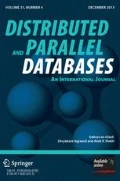Abstract
Heterogeneous as well as distributed databases make data conflicts inevitable. Both tolerate the entry of conflicting values in data objects, e.g., the value “female” may be entered by one user whereas another may put “male” in the same data object. Such inconsistencies in databases are common and are resolved routinely by built in structured mechanisms. Unresolved conflicts are typically quarantined till they can be resolved. But, there are situations for which there are no structured mechanisms to resolve conflicts while having to maintain application flow. Moreover, there are situations, i.e., medical or financial environments, in which conflicts must be stored so that their effects be analyzed for decision making. The current research proposes a model and a technique for living with database conflicts. The technique, named Temporal Branching, integrates and extends temporal oriented databases, temporal versioning, and log-file approaches and offers a solution and flexible structure readily accessible to retrieval and audits by standard DBMS software. A case study in health care delivery system is given to illustrate the problem and proposed solution.
References
M. Ahamad, M.H. Ammar, and S.Y. Cheung, “Replicated data management in distributed systems,” in Readings in Distributed Computing Systems, Thomas L. Casavant and Mukesh Singhal (Eds.), IEEE Computer Society Press, 1994.
P. Anastassopoulos and J. Dollimore, “A unified approach to distributed concurrency control,” in Readings in Distributed Computing Systems, Thomas L. Casavant and Mukesh Singhal (Eds.), IEEE Computer Society Press, 1994.
G. Ariav, “A temporally oriented data model,” ACM Transactions on Database Systems, vol. 11, no. 4, pp. 499–527, 1986.
M.J. Carey and M. Livny, “Conflict detection tradeoffs for replicated data,” ACM Transaction of Database Systems, vol. 16, no. 4, pp. 703–746, 1991.
C. Combi and Y. Shahar, “Temporal reasoning and temporal data maintenance in medicine: Issues and challenges,” Computers in Biology and Medicine, vol. 27, no. 5, pp. 353–368, 1997.
B.F. Cooper and H. Garcia-Molina, “Peer-to-peer data trading to preserve information,” ACM Transactions on Information Systems, vol. 20, no. 2, pp. 133–170, 2002.
R. Elmasri and Nevathe, Fundamentals of Database Systems, 2nd edition, Benjamin Cummings, Redwood City: CA, 1994.
FDA, Electronic Records; Electronic Signatures; Final Rule, (21 CFR Part 11), Federal Register, vol. 62, no. 52, pp. 13430–13466.
S.H. Hong and M. H. Kim, “Resolving data conflicts with multiple versions and precedence relationships in real-time databases,” Information Processing Letters, vol. 61, pp. 149–156, 1997.
ICH, “Guideline for good clinical practice,” (ICH topic 6) The European Agency for the Evaluation of Medical Products (EUDRA), 1996.
W.H. Inmon, Building the Data Warehouse, 2nd ed., Wiley: New York, 1996.
C.S. Jensen and C.E. Dyreson (Eds.), “The consensus glossary of temporal database concepts,” Temporal Databases-Research and Practice Lecture Notes in Computer Science, vol. 1388, Springer-Verlag, Berlin 1998, pp. 368–405.
D.A. Lepay, “Guidance for industry: Computerized systems used in clinical trials,” (draft), Federal Register, vol. 62, 33094, 1997.
T. P. Loomis, “Audit history and time-slice archiving an object DBMS for laboratory databases,” HP Journal, Article 10, August 1997.
Lü Jiang, P. Barclay, and J. Kennedy, “On temporal versioning in temporal databases,” Informationssystem-Architekturen, vol. 3, no. 1, pp. 38–40, 1996.
Oracle, “Introduction to Oracle8 Advanced Replication,” White Paper, www.oracle.com, June 1997.
G. Özsoyogulu and R.T. Snodgrass, “Temporal and real-time databases: A survey,” IEEE Trans. on Knowledge and Data Engineering, vol. 7, no. 4, pp. 513–532, 1995.
Y. Shiftan, “Managing table databases incorporating the time dimension,” (Hebrew), Computers, Sept. 1990, Israel.
J. F. Studebaker, “Computers in the new drug application process,” J. Chem. Inf. Comput. Sci., vol. 33, pp. 86–94, 1993.
C. Tansel, J. Gadia, A. Segev, and R. Snodgrass, Temporal Databases: Theory, Design, and Implementation, Benjamin/Cummings, USA, 1993.
A. Thomasian, “Concurrency control: Methods, performance, and analysis,” ACM Computing Surveys, vol. 30, no. 1, 1998.
Yu Wu, Sushil Jajodia and Sean Wang, X., “Temporal database bibliography update,” Temporal Databases- Research and Practice, Lecture Notes in Computer Science, vol. 1388, Springer-Verlag, Berlin 1998, pp. 368–405.
Author information
Authors and Affiliations
Corresponding author
Additional information
recommend Ahmed Elmagarmid
Rights and permissions
About this article
Cite this article
Gelbard, R., Spiegler, I. Living with Database Conflicts: A Temporal Branching Technique. Distrib Parallel Databases 17, 251–265 (2005). https://doi.org/10.1007/s10619-005-6831-1
Issue Date:
DOI: https://doi.org/10.1007/s10619-005-6831-1

